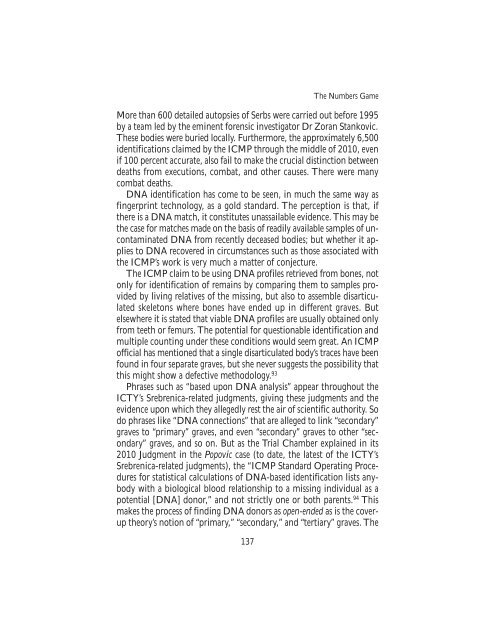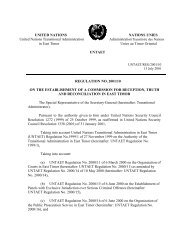The Srebrenica Massacre - Nova Srpska Politicka Misao
The Srebrenica Massacre - Nova Srpska Politicka Misao
The Srebrenica Massacre - Nova Srpska Politicka Misao
Create successful ePaper yourself
Turn your PDF publications into a flip-book with our unique Google optimized e-Paper software.
<strong>The</strong> Numbers Game<br />
More than 600 detailed autopsies of Serbs were carried out before 1995<br />
by a team led by the eminent forensic investigator Dr Zoran Stankovic.<br />
<strong>The</strong>se bodies were buried locally. Furthermore, the approximately 6,500<br />
identifications claimed by the ICMP through the middle of 2010, even<br />
if 100 percent accurate, also fail to make the crucial distinction between<br />
deaths from executions, combat, and other causes. <strong>The</strong>re were many<br />
combat deaths.<br />
DNA identification has come to be seen, in much the same way as<br />
fingerprint technology, as a gold standard. <strong>The</strong> perception is that, if<br />
there is a DNA match, it constitutes unassailable evidence. This may be<br />
the case for matches made on the basis of readily available samples of uncontaminated<br />
DNA from recently deceased bodies; but whether it applies<br />
to DNA recovered in circumstances such as those associated with<br />
the ICMP’s work is very much a matter of conjecture.<br />
<strong>The</strong> ICMP claim to be using DNA profiles retrieved from bones, not<br />
only for identification of remains by comparing them to samples provided<br />
by living relatives of the missing, but also to assemble disarticulated<br />
skeletons where bones have ended up in different graves. But<br />
elsewhere it is stated that viable DNA profiles are usually obtained only<br />
from teeth or femurs. <strong>The</strong> potential for questionable identification and<br />
multiple counting under these conditions would seem great. An ICMP<br />
official has mentioned that a single disarticulated body’s traces have been<br />
found in four separate graves, but she never suggests the possibility that<br />
this might show a defective methodology. 93<br />
Phrases such as “based upon DNA analysis” appear throughout the<br />
ICTY’s <strong>Srebrenica</strong>-related judgments, giving these judgments and the<br />
evidence upon which they allegedly rest the air of scientific authority. So<br />
do phrases like “DNA connections” that are alleged to link “secondary”<br />
graves to “primary” graves, and even “secondary” graves to other “secondary”<br />
graves, and so on. But as the Trial Chamber explained in its<br />
2010 Judgment in the Popovic case (to date, the latest of the ICTY’s<br />
<strong>Srebrenica</strong>-related judgments), the “ICMP Standard Operating Procedures<br />
for statistical calculations of DNA-based identification lists anybody<br />
with a biological blood relationship to a missing individual as a<br />
potential [DNA] donor,” and not strictly one or both parents. 94 This<br />
makes the process of finding DNA donors as open-ended as is the coverup<br />
theory’s notion of “primary,” “secondary,” and “tertiary” graves. <strong>The</strong><br />
137



